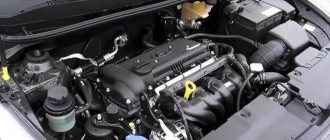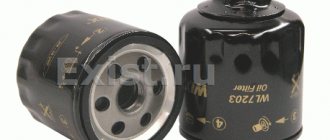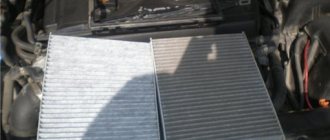The Czech car manufacturer Skoda is part of the no less famous concern Volkswagen AG. Cars are valued for their high quality, reliability and practicality. Another advantage is the relatively low price of the Skoda Octavia, in comparison with other brands produced by the concern.
Popular engines among model owners are 1.6 mpi and 1.8 tsi, which work great with proper maintenance. Timely replacement of engine oil for Skoda Octavia a5, a7 is the key to long-term operation of the power plant without repair.
Instructions for changing engine oil yourself in a Skoda Octavia car
Often, for novice motorists who own a Skoda Octavia, changing the oil seems like an almost insoluble problem. While some people try to understand the car’s structure on their own, studying thematic forums and practical advice from experienced specialists, others, fearing damage to expensive property, entrust such work only to service center employees.
Preparatory activities
If the Skoda Octavia requires an oil change, before starting work, it is extremely important to fulfill one condition, namely, warm up the power unit. In addition, you need to prepare the necessary materials and tools and drain the oil using a lift. However, in such a situation, when this device is not available, you will have to look for an inspection hole or overpass. As practice shows, especially brave car enthusiasts use a jack, among other tools; a car raised in this way must necessarily stand on the handbrake; it is preferable to place wooden stands under its wheels, which will prevent the vehicle from rolling away.
Skoda Octavia A7 - how much oil is in the engine (volume)
How many liters should I fill?
The amount of engine oil relative to engine size and serial number is as follows:
- 1.2 TSI (CBZB) – 4.0 l;
- 1.4 TSI (CGGA) – 3.2 l;
- 1.4TSI (G052167M2) – 4.0 l;
- 1.6 MPI (BSE) – 4.5 l;
- 1.8 TSI (CDAA) – 4.5 l;
- 1.9 TSI (BLS) – 4.3 l;
- 2.0 TDI (CLCA) – 4.6 l.
Consequently, the amount of oil for the Skoda Octavia A7 does not exceed 5 liters, which means that for a complete change one 5-liter canister will be sufficient. For engines with a volume of 1.2, 1.4, 1.6 liters, power up to 150 horsepower, use oil with VW 502 approval. For more powerful models, the recommended VW 504/505/507 approval. The greater the power, the higher the fluid wear rate, and, accordingly, the oil tolerance will be higher.
Advice: Unlike turbocharged 1.2 and 1.4 engines, the classic naturally aspirated 1.6 does not consume oil.
But in the case of the TSI line, we recommend stocking up on an additional 1 liter of oil, which you will probably need, since the norm for adding oil is 0.5-1 liter per 5,000 km.
Features of DSG units on Skoda Kodiaq
The DSG transmission is a gearbox design (its abstruse name is a preselective gearbox) that has two parallel clutches for quickly switching speed modes. In this case, one of them is used for the speeds of the odd row, and the second is used to enable the speeds of the even row.
This allows for almost instantaneous switching of speed modes, essentially without interruption of rotational forces, for their transmission from the engine to the transmission actuators.
By the way, classic automatic transmissions do not have the ability to quickly change gears, since it takes them much longer.
Features of the Skoda Kodiak gearbox Despite the modern design of the Skoda Kodiak body and its comfort for the driver, many are interested in the question
For fans of the Skoda Kodiaq, as well as for fans of other car brands, it is of no small importance: for some, it’s the starting capabilities of their car, and for others, it’s a smooth and measured movement in traffic.
Therefore, perhaps, for some of them, DSG transmissions may not be entirely comfortable.
But here, as they say, regarding the advantages and disadvantages of DSG, the questions are not so much general, but rather personal, or depending on a particular behavior and experience of drivers.
For aggressive driving on the road, the instantaneous gearshift transmission is quite suitable, but for calm road behavior, such capabilities of the box, in general, are useless, despite the obvious advantages of this preselective gearbox.
Comparison of the Skoda Kodiak with competitors in the domestic market The Skoda Kodiaq crossover is quite in demand in the domestic market. Peculiar body shapes and relatively
Advantages of transmissions equipped with DSG
Among the advantages of quick-shift gearboxes, the following should be highlighted:
- – reduction in the acceleration period of the car, which means saving fuel;
- – due to smooth switching and absence of jerks, increased transmission life;
- – no clutch pedal;
- – availability of manual control of driving modes.
Types of DSG boxes
Among the versions of DSG boxes, the most famous are:
- – DSG-6. Or a six-mode gearbox with a “wet” double clutch. The first versions of such units began to be installed on cars in 2003. They are equipped with engines in the range from 1.6 to 3.2 liters, for cars such as Skoda and Volkswagen, as well as Seat;
- – DSG-7. Accordingly, it has 7 speeds. The main difference from the previous version is that it is “dry” and designed for reduced torque parameters. Since 2008, it has been equipped with Golf and Polo models;
- – VAG-500. Or a modernized version of the DSG, which is adapted to adapt to engines with torques within 500 N*m of such models as the Chinese-made Tiguan, Transporter, as well as the Skoda Kodiak configuration. Technical characteristics of the “Simply Smart” Skoda Kodiak “Simply Smart” is the slogan of the Czech concern, and it most fully suits the definition stuffed with “smart”
Features of DSG operation
As already mentioned, the DSG has good dynamic and fuel characteristics inherent in the reliability of manual transmissions, as well as the comfort of hydromechanical automatic transmissions. But there are some operational features, despite the similarity of DSG designs to each other.
Moreover, the differences between DSG-6 and DSG-7 are that the first is a “wet” unit, and the second is a “dry” unit.
In addition, the DSG-7 has lower permissible parameters for transmitting rotational forces, which means that aggressive driving is contraindicated for it.
The fact is that a “wet” gearbox or one with a clutch in an oil bath has more reliable wear protection than a “dry” clutch.
There are enough cases where DSG-7 units did not last even 70,000 miles for aggressive drivers.
As for the nuances of operating transmissions such as DSG, you should remember that:
- – when driving in a traffic jam, the automatic transmission can quickly switch the speed mode from first to second gear and, if you don’t “push on the gas,” it will switch back to first gear;
- – although in order to switch to a lower speed, it is recommended to press the brake pedal, but if the brake is not fully depressed, such a switch may not occur;
- – you should not switch the DSG gearbox lever to position N at a traffic light, because such switches lead to increased wear of the clutch. When stopping in traffic jams, you also do not need to move the lever to position N; to do this, just squeeze the brake, which will automatically release the clutch;
- – when setting the parking mode, you should still apply the parking brake to protect the mechanism preventing rollback;
- – the use of cars with differentials equipped with DSG-7 as towing means, both for trailers and for disabled cars, should be moderate. As, by the way, is overloading the luggage compartments when there is a full complement of passengers. However, these warnings do not apply to Skoda Kodiak with DSG-6;
- – in order to overcome road sections of snow and mud where it is necessary to use rocking, you should not do this, but you need to put the gearbox lever in position N and call for outside help.
Regarding maintenance, DSG requires these procedures to be carried out more often than, for example, a manual transmission. They should also be carried out in specialized services, and not in your own garages. At least 60 thousand mileage, you need to change the oil in the unit along with replacing the filter.
New Skoda Kodiak or Tiguan: comparison of cars Skoda Kodiak and Volkswagen Tiguan are direct competitors and almost twins in technical terms. Currently price
As a result
Taking into account all the features of the DSG on a car like the Skoda Kodiaq, which, according to experienced car enthusiasts, supposedly do not fully correspond to the national characteristics of our road and climatic conditions, nevertheless, this transmission is more preferable and popular for the new generation of motorists.
Fast passage:
Source: https://skoda-auto2.ru/dsg-shkoda-kodiak-pljusy-i-minusy-korobki/
How to choose oil
When choosing oil, the car owner is divided into two categories:
- only original and expensive;
- need to find it cheaper.
When choosing an oil and filter, it is worth considering that you need to pour it into the engine only with the same markings and preferably the original, while the car is at the break-in stage. If not, then you need to rinse it thoroughly and replace it with another manufacturer without changing the viscosity. That is, if synthetic was poured, then synthetic should be poured.
The original oil, which is poured into the Skoda Octavia A7, is marked “Longlife III 5W-30” and has VAG G 052 195 M4. Based on these data, you can easily select an analogue.
Why Castrol
There are many reasons for this. The products of this manufacturer best suit the characteristics of Skoda Octavia A7 engines. But there are also important nuances here. For example, Castrol has certain temperature parameters. But in any case, to be confident in the quality of the product, you need to pay attention to the appropriate markings on the product packaging: ACEA A3/B4, as well as API SL/CF. Based on this information, it is possible to select an oil with suitable parameters: for example, Castrol EDGE 0W40 A3/B4.
Replacement frequency, what oil to fill
According to the manufacturer's regulations, service changes of engine oil for Skoda Octavia are carried out after 15,000 kilometers or at intervals of 1 year. But some car owners consider this interval to be a little too high, recommending that it be shortened taking into account operating conditions.
The original oil that the manufacturer recommends is Volkswagen Special Plus 5w-40, also known as VAG Special G 5w-40. Available in 1 liter G 052 167 M2 and 5 liter G 052 167 M4.
In addition, it is also recommended to use Castrol lubricant, as evidenced by the inscription on the engine oil filler neck. The Castrol EDGE 5W-30 A3/B4 marking has all the necessary approvals. The inscription Professional and the VW sign may also be present.
Sometimes owners of an Octavia a5, a7 car have a misunderstanding about what viscosity should be chosen: 5w30 or 5w40. The fact is that the manufacturer gives a recommendation when choosing to focus on the VW 502.00 tolerance. And the viscosity is selected based on the climatic zone of use of the machine. By the way, it can be 0W30. But most often, dealers in central Russia fill in 5W-40.
The manufacturer also allows the use of analogues that meet the approval of the VAG concern: VW 502.00. The following brands are most popular among car owners:
- Castrol Magnatec 5W-40 A3/B4
- Liqui Moly Synthoil High Tech 5W-40
- Mobil 1 FS X1 5W-40
- Motul 8100 X-cess 5W40
- RAVENOL VollSynth Turbo VST 5W-40
- Shell Helix Ultra 5W-40
- Total Quartz 9000 5W-40
- Valvoline Synpower 5W-40
- ZIC X9 5W-40
- Lukoil Genesis Armortech 5W-40
From this list, anyone can choose based on preference, price or love for the brand.
How much oil is in the engine lubrication system, volume table
Stages of replacing lubricant Skoda Octavia A5, A7
Changing engine oil for a Skoda Octavia is carried out according to the standard procedure: first, the old waste is drained, the filter element is changed and new oil is poured. Access to components during replacement is quite convenient, so you can carry out maintenance yourself.
The replacement operation will be the same for gasoline and diesel versions, as well as various modifications:
- Skoda Octavia a7
- Skoda Octavia a5
- Skoda Octavia tour barrel
- Skoda Octavia tour
Draining waste fluid
It is necessary to drain the used engine fluid when the engine is warm. This is due to the fact that heated oil is more liquid. This makes it easier for it to leak out of the thin channels of the lubrication system.
To drain old engine oil, it is advisable to drive the Skoda Octavia A5, A7 onto a pit or overpass, since the drainage is done from below. If this is not possible, then the most inconvenient step will be unscrewing the drain plug. Especially if there is protection installed that will need to be removed.
Due to the wide variety of engines installed on this model, it is not possible to describe the process for all. But the actions will be identical, the only difference is the location of the filter element. We are making a replacement on a 1.6 mpi engine.
When everything is ready, we proceed to the draining operation:
- Raise the hood, then find the filler neck on the engine and unscrew the cap (Fig. 1).
Fig.1 Oil filler neck - We unscrew the oil filter, which is located in the front of the engine, under the hood. Visually, it is located to the right of the generator, directly under the probe (Fig. 2).
Fig.2 Oil filter - Now we go down under the car and place a waste container in the drainage area. You can use a cut canister or an old bucket.
- Unscrew the drain plug using a 19 mm wrench or socket (Fig. 3).
Fig.3 Drain plug - The drain plug is not located at the lowest point, so about 150-250 milliliters of waste may remain in the pan. To remove them, you can use a rubber bulb or a syringe with a hose attached to it (Fig. 4).
Fig.4 Pumping out residues with a syringe
To unscrew the filter element, it is advisable to have a special puller. If it is not available, you can try to unscrew the filter using improvised means. In this case, you can use, for example, an old alternator belt, a regular belt, a bicycle chain or a simple screwdriver.
Unscrewing the oil filter using improvised means
Using this method, you can drain the maximum amount of used oil, after which you can proceed to further actions. The main thing is not to forget, everything that we unscrewed must be put back in place.
Flushing the lubrication system
- Engine flushing on a Skoda Octavia should only be carried out in exceptional cases, which include:
- Purchasing a used car when you cannot know about the quality, as well as the regularity of lubricant replacements.
- During operation, the service replacement interval was repeatedly exceeded.
- Engine operation with constant frequent overheating, which contributes to coking and other deposits.
- In cases of switching to another type, for example from synthetics to semi-synthetics.
There are several types of flushes for the Skoda Octavia engine:
- Five- or seven-minute, capable of cleaning even the most difficult deposits. They must be used very carefully and strictly follow the instructions printed on the packaging. It is recommended to use them only when absolutely necessary. Since there is a high probability of causing premature wear of the sealing seals. And also clog the oil channels with particles of washed away carbon deposits.
- Special compounds that are added to the oil several hundred kilometers before the expected change. They are more gentle, but there is also a possibility of clogging of the oil channels.
- Flushing oil is the most gentle method of cleaning the engine from the inside. This composition is poured after draining the waste, the engine runs for 15-20 minutes, after which the liquid with deposits is drained. The absence of aggressive additives in the wash composition gently cleans the engine, but is not able to remove heavy contaminants.
- Regular oil that you are going to use when changing. This method is not so popular due to its high price.
Before flushing your Skoda Octavia, you should weigh all the pros and cons. And also understand that it will not be possible to completely drain the liquid. Some of it will remain in the channels, which will then mix with the new oil.
Installing a filter, filling in new engine fluid
If the Skoda Octavia lubrication system is sealed and does not require repair work to eliminate leaks, you can proceed to adding fresh oil. In addition to the engine oil itself, the manufacturer in the operating instructions recommends changing the bolt that closes the drain hole.
Consumables for maintenance
It comes complete with a washer gasket and has part number VAG N 908 132 02. As well as the original oil filter VAG 06A 115 561 B. If you wish, you can look for analogues on the Internet.
When everything is ready, let's move on to the bay:
- Replace the drain plug and replace it with a new one if necessary.
- We wipe the seat under the filter.
- We tighten and put in place the new oil filter. Pre-lubricate the rubber sealing ring with fresh oil.
- Pour new oil into the filler neck.
- We check the level on the dipstick; it should be between the MIN and MAX marks.
- We start the engine, let it run for 10-15 seconds, then turn it off.
- After 5 minutes, check the level with a dipstick and top up if necessary.
There are several opinions regarding replacing the oil filter. Many old-school owners advise filling it with new oil before installation. However, nothing is said about this in the official operating instructions for the Skoda Octavia. And also in information from global filter manufacturers it is recommended to simply lubricate the o-ring.
Resetting the interservice oil change counter
To reset the service on the Skoda Octavia A7, do the following:
- Turn off the ignition and with the car turned off, press the “0.0/SET” button located under the LCD display of the instrument panel.
- With the button held down, turn on the ignition, the message “Resetting oil display” will appear.
- Quickly release the button and press it again.
- The inspection service is also reset in the same way; when the message “Resetting the maintenance display” appears, quickly release the button and press it again.
When resetting the indication, the car doors must be closed. In some cases, this causes problems with reset.
After passing these points, the service interval will be reset and information until the next maintenance will appear on the meter.
Leaks and problems
The higher the mileage of the Skoda Octavia, the more problems appear, as in principle with any car. Most often this is due to natural wear and tear of the engine, causing oil to burn. Although the manufacturer allows for a small consumption.
In general, speaking about burns on this model, it is worth noting that some engines are susceptible to it, especially the new generation. The manufacturer himself admits this and writes about it in the instructions that consumption can be 1 l/2000 kilometers.
If the car is under warranty and the consumption is more than 0.5 l/1000 kilometers, then you can go to the dealer. This is a warranty case, but in practice such costs are exceptions. Typically, oil consumption does not exceed 1 l/10,000 kilometers.
Owners note the engine's sensitivity to bad oil. Therefore, it is advised to purchase it from official suppliers to avoid buying a counterfeit. It is also worth reducing the replacement interval and focusing on engine hours; the optimal interval is considered to be 250-300 engine hours.
All this is general information, which may manifest itself differently on each specific vehicle, since everyone’s operating modes are different. The same applies to leak locations; it is impossible to identify the cause from a distance.
Oil pressure sensor
If the oil pressure sensor lights up, then an exciting set of checks of the engine and individual components awaits you. What could cause the sensor to light up?
- Low level of oil pressure in the engine. The simplest option is to check the dipstick, if you add too little to the required level.
- Oil too old. Look at the color of the oil, rub it with your fingers (you should feel oily). If the oil is too old, it is better to change it to a new one.
- Oil pump malfunction.
- The oil pressure sensor has failed. If you checked the previous steps and nothing helped, check the sensor itself. A visual inspection will help determine the external condition of the device. If necessary, replace with a new one. It happens that the sensor is covered in oil, this may indicate that the leak is coming through the sensor. Of course, such a part must be replaced immediately.











